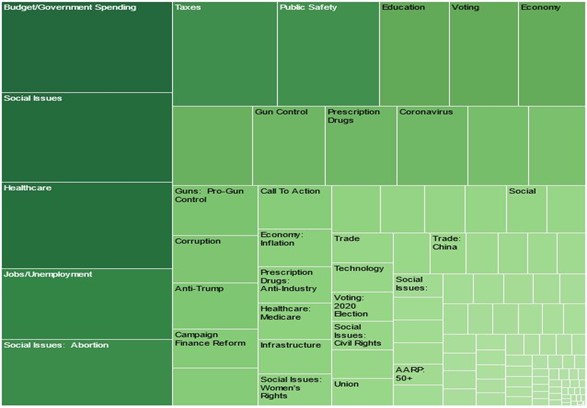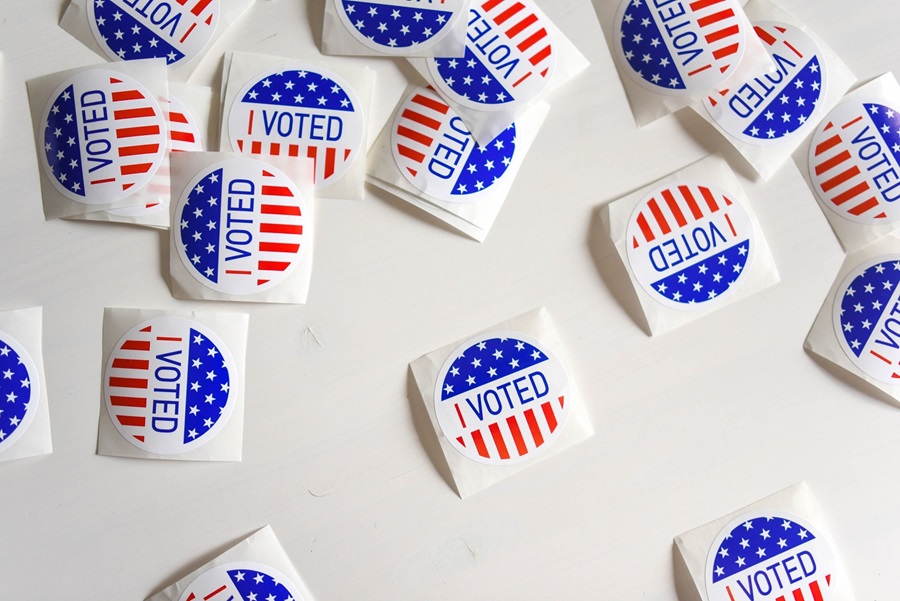We are at the halfway point for the 2022 midterms and ad spending is on pace to break all previous records. When assessing the messaging in campaign advertising, we can ascertain the issues that each party values and believes will bring them to victory in November.
When looking at Democrat messaging across all races we determine that “Budget/Govt Spending” has seen the most dollars behind it, at $25.7 million. Invariably, this issue appears in two ways in their spots: calling attention to COVID-19 relief funds meant to ameliorate the effects of pandemic-related shutdowns and interruptions to the economy, as well as tapping into constituent concerns about inflation. “Social issues,” which touches on topics related to various civil rights, clocks in at second in terms of spending at $25.3 million.
Unsurprisingly, “Healthcare,” an issue which has been a Dem strength for decades slots into the third position with $24 million in spending. “Jobs/Unemployment,” which always figures prominently in any political ad campaign, comes in fourth with a $20 million expenditure. Rounding out the top five were ads referencing “abortion” with $18.8 million in ad spend. Though we forecast spending related to this issue to increase as the general election approaches and following the Supreme Court's ruling on Roe v. Wade.

When viewing the top five issues appearing in Democratic advertising from an airings perspective, the rankings are similar but slightly modified. Democrats are saturating the airwaves with their strongest issue - Healthcare – which saw 106,492 airings thus far in 2022. “Budget/Govt Spending” comes in second with 101,583 occurrences and “Social Issues” slots into third position with 94,346 ad airings.
Creatives mentioning “Jobs/Unemployment” nips at its heels with 94,259 occurrences while “public safety” [76,602] - tapping into bipartisan concerns regarding crime and policing - closes out the top five issues thus far.
The Republicans bear the unmistakable influence of Donald Trump in their ad messaging. Concerns related to “Immigration” - the issue that enabled the former president’s unlikely 2016 victory - has seen the most ad spend with $45.5 million. Ads attacking President Biden [“Anti-Biden:] are a close second with $45.3 million in spending.
Much the same as the Democrats are doing - though to a greater extent - the GOP has aggressively messaged on concerns related to “public safety,” spending approximately $42.6 million on this issue in their ad campaigns. Spots boosting former President Trump [“Pro Trump”] came in fourth on this list with a $41.1 million expenditure while ads referencing “Budget/Govt Spending” - often coupled with inflation specifically - was in fifth position with $40.6 million spent.
When viewing these rankings from an airings perspective, themes are similar. Creatives touching upon “Public Safety” were the most heavily advertised so far this year with 237,597 airings. “Taxes” - though not figuring in the top five by spending - came in second with 232,001 occurrences while “Anti-Biden” spots slotted into third with 230,122 airings. “Budget/Govt Spending” is close behind in fourth place with 230,099 ad airings while “Immigration” closed out the top five with 229,218 occurrences.
Reading between the lines, Kantar can see a pattern emerging. The GOP is doubling down on their 2016-2020 playbook, essentially betting on a Trumpian strategy - targeting immigration, concerns about crime, targeting an unpopular president while harkening back to a similarly unpopular one. While the Democrats are backing off the progressive messaging that attended their 2020 election strategy- less focus on “reimagining” the police, white supremacy and structural inequities and more focus on their traditional strengths like healthcare, access to abortion and jobs.

